Research on Fault Detection and Automatic Diagnosis Technology of Water Hammer in Centrifugal Pump
Abstract
:1. Introduction
- Methods for the online monitoring and diagnosis of water hammer faults are still limited in practical engineering applications.
- Monitoring methods have lag. Traditional monitoring methods have lag and are difficult to respond to and address potential equipment damage and safety hazards in a timely manner.
- Monitoring methods have low data processing efficiency and a strong dependence on manual intervention. Traditional monitoring methods have low efficiency in data collection and transmission, and the diagnostic process relies on manual labor, which affects time and accuracy, while increasing costs and manpower requirements.
- A centrifugal pump water hammer monitoring method is proposed, which can effectively capture and record water hammer events, providing new ideas for practical engineering applications.
- The introduction of edge layer and cloud collaborative data processing and transmission methods improves the efficiency of data processing and real-time transmission, providing reliable technical support for timely prevention and handling of water hammer events.
- An intelligent water hammer monitoring and diagnosis system is designed, which has self-learning alarm thresholds and can automatically send alarm messages, achieving automatic fault diagnosis and reducing reliance on manual labor.
2. Failure Mechanism and Vibration Characteristics
2.1. Failure Mechanism
2.2. Vibration Characteristics
3. Monitoring Method of Water Hammer Failure
4. Design of Water Hammer Fault Monitoring and Diagnosis System
4.1. Composition of Monitoring System
4.2. Monitoring System Data Collection and Scheduling Method
5. Test and Experiment
5.1. Test Object
5.2. Experimental Methods
5.3. Analysis of Results
5.4. Experimental Results
6. Conclusions
- In response to the difficulty in monitoring water hammer in centrifugal pumps, the proposed water hammer fault monitoring method and diagnostic model can achieve timely capture, early warning and rapid response to water hammer events.
- In view of the problem that water hammer events are difficult to deal with in time, this paper adds edge computing to the data acquisition module, which makes full use of the computing power of the edge layer, reduces the computing pressure of the server and improves the data transmission speed and the processing efficiency of water hammer events.
- After experimental testing, the water hammer monitoring and diagnosis system designed in this article can effectively collect operational data of centrifugal pumps and intelligently identify faults based on the characteristics of centrifugal pump water hammer faults.
Author Contributions
Funding
Institutional Review Board Statement
Informed Consent Statement
Data Availability Statement
Conflicts of Interest
References
- Sunal, C.E.; Dyo, V.; Velisavljevic, V. Review of Machine Learning Based Fault Detection for Centrifugal Pump Induction Motors. IEEE Access 2022, 10, 71344–71355. [Google Scholar] [CrossRef]
- Jardine, A.K.S. Vibration Monitoring in Industry: Then and Now. IEEE Trans. Reliab. 2024, 73, 31–32. [Google Scholar] [CrossRef]
- Yu, R.; Liu, J. Failure analysis of centrifugal pump impeller. Eng. Fail. Anal. 2018, 92, 343–349. [Google Scholar] [CrossRef]
- Ahmad, Z.; Rai, A.; Maliuk, A.S.; Kim, J.M. Discriminant Feature Extraction for Centrifugal Pump Fault Diagnosis. IEEE Access 2020, 8, 165512–165528. [Google Scholar] [CrossRef]
- Cao, Y.; Wang, J.; Dou, Y.; Huang, Y. Vibration Response of Fracturing Tubing Induced by Water Hammer. Mach. Tool Hydraul. 2019, 47, 1–7. [Google Scholar] [CrossRef]
- Li, S.; Meng, L.; Xu, X.; Lou, Y. Influence of Opening Characteristics for Ultra-supercritical Steam Trap on Water Hammer Induced Pipe Vibration. J. Vib. Meas. Diagn. 2017, 37, 1169–1174, 1280. [Google Scholar] [CrossRef]
- Urbanowicz, K.; Jing, H.; Bergant, A.; Stosiak, M.; Lubecki, M. Progress in Analytical Modeling of Water Hammer. J. Fluids Eng. Trans. Asme 2023, 145, 081203. [Google Scholar] [CrossRef]
- Liu, M.; Liang, X.; Liu, Z.; Lin, Q.; Wu, Y. Field Measurement of Water Hammer and Signal Analysis at Pump-Stop Due to Power Failure in Long Water-Supply Pipeline. J. Drain. Irrig. Mach. Eng. 2012, 30, 249–253. [Google Scholar] [CrossRef]
- Britton, L.G.; Willey, R.J. Avoiding Water Hammer and Other Hydraulic Transients. Process Saf. Prog. 2024, 43, 101–112. [Google Scholar] [CrossRef]
- Wu, L.; Wang, H.; Li, X.; Sang, Z.; Chen, Z. Ultimate Bearing Capacity Analysis of Pipelines under Water Hammer. J. Pipeline Syst. Eng. Pract. 2024, 15, 04023063. [Google Scholar] [CrossRef]
- Zhang, X.; Bian, S.; Feng, M.; Lu, W.; Zhang, J. Experimental study on direct water hammer pressure characteristics in PMMA pipelines. J. Drain. Irrig. Mach. Eng. 2024, 42, 37–42. [Google Scholar] [CrossRef]
- Yu, Y.; Wang, J.; Qin, X. Hydraulic vibration analysis of parallel pump system with air surge tank for water hammer protection. J. Drain. Irrig. Mach. Eng. 2013, 31, 958–963. [Google Scholar] [CrossRef]
- Bazargan-Lari, M.R.; Kerachian, R.; Afshar, H.; Bashi-Azghadi, S.N. Developing an optimal valve closing rule curve for real-time pressure control in pipes. J. Mech. Sci. Technol. 2013, 27, 215–225. [Google Scholar] [CrossRef]
- Bergant, A.; Tijsseling, A.S.; Vítkovský, J.P.; Covas, D.I.C.; Simpson, A.R.; Lambert, M.F. Parameters affecting water-hammer wave attenuation, shape and timing—Part 1: Mathematical tools. J. Hydraul. Res. 2008, 46, 373–381. [Google Scholar] [CrossRef]
- Liu, Z.; Bi, H.; Wang, F. Effect of air valves on water hammer protection in pressure pipelines. J. Drain. Irrig. Mach. Eng. 2011, 29, 333–337. [Google Scholar] [CrossRef]
- Wang, X.; Zhang, J.; Yu, X.; Chen, S.; Zhao, W.; Xu, H. Effect of multi-valve closure on superposed pressure in a tree-type long distance gravitational water supply system. J. Water Supply Res. Technol. AQUA 2019, 68, 420–430. [Google Scholar] [CrossRef]
- Urbanowicz, K.; Bergant, A.; Stosiak, M.; Karpenko, M.; Bogdevicius, M. Developments in analytical wall shear stress modelling for water hammer phenomena. J. Sound Vib. 2023, 562, 117848. [Google Scholar] [CrossRef]
- Wan, W.; Zhang, B.; Chen, X. Investigation on Water Hammer Control of Centrifugal Pumps in Water Supply Pipeline Systems. Energies 2019, 12, 108. [Google Scholar] [CrossRef]
- Hu, J.; Wang, C.; Shan, C.; Guo, Y. Monitoring and Analysis of the Operation Performance of Vertical Centrifugal Variable Frequency Pump in Water Supply System. Energies 2023, 16, 4526. [Google Scholar] [CrossRef]
- Arun Shankar, V.K.; Subramaniam, U.; Padmanaban, S.; Holm-Nielsen, J.B.; Blaabjerg, F.; Paramasivam, S. Experimental Investigation of Power Signatures for Cavitation and Water Hammer in an Industrial Parallel Pumping System. Energies 2019, 12, 1351. [Google Scholar] [CrossRef]
- Han, J.; Zhang, R. Fault Mechanism and Diagnostic Technology of Rotating Machinery; Machinery Industry Press: Beijing, China, 1997; pp. 36–37. [Google Scholar]
- Chen, Y.; Liu, B.; Lin, W.; Cheng, H. Survey of Cloud-edge Collaboration. Comput. Sci. 2021, 48, 259–268. [Google Scholar] [CrossRef]
- Yao, J.; Zhang, S.; Yao, Y.; Wang, F.; Ma, J.; Zhang, J.; Chu, Y.; Ji, L.; Jia, K.; Shen, T.; et al. Edge-Cloud Polarization and Collaboration: A Comprehensive Survey for AI. IEEE Trans. Knowl. Data Eng. 2023, 35, 6866–6886. [Google Scholar] [CrossRef]
- Tong, Z.M.; Xin, J.G.; Tong, S.G.; Yang, Z.Q.; Zhao, J.Y.; Mao, J.H. Internal flow structure, fault detection, and performance optimization of centrifugal pumps. J. Zhejiang Univ. Sci. A 2020, 21, 85–117. [Google Scholar] [CrossRef]
- Wang, Y.; Xiong, W.; Ding, Z.; Pi, Q.; Yuan, X.; Liu, H.; Li, M. Water Hammer Characteristics in Pressurized Pipeline Based on CFD. J. Drain. Irrig. Mach. Eng. 2023, 41, 1156–1162. [Google Scholar] [CrossRef]
- Dutta, N.; Palanisamy, K.; Subramaniam, U.; Padmanaban, S.; Holm-Nielsen, J.B.; Blaabjerg, F.; Almakhles, D.J. Identification of Water Hammering for Centrifugal Pump Drive Systems. Appl. Sci. 2020, 10, 2683. [Google Scholar] [CrossRef]



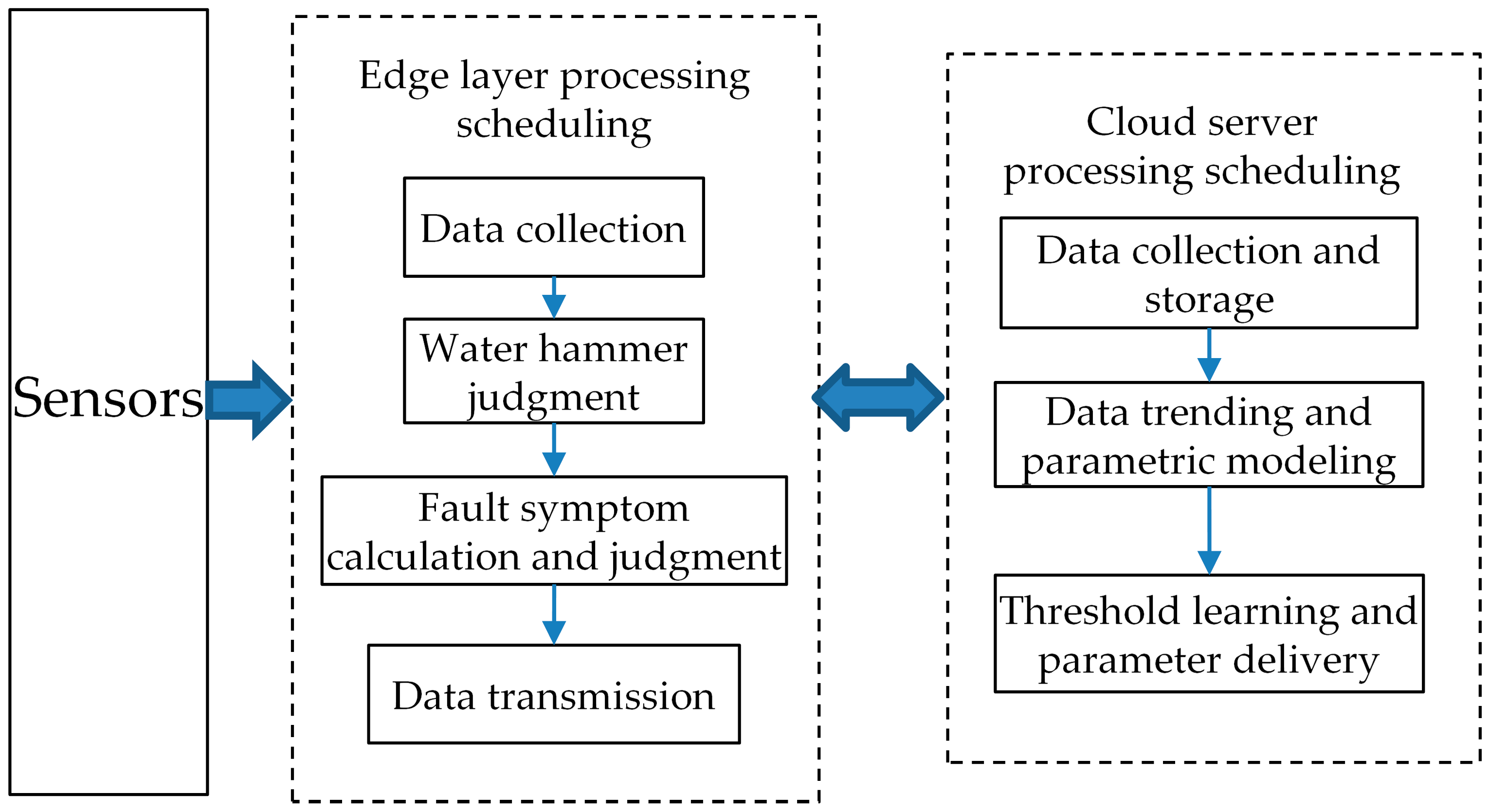
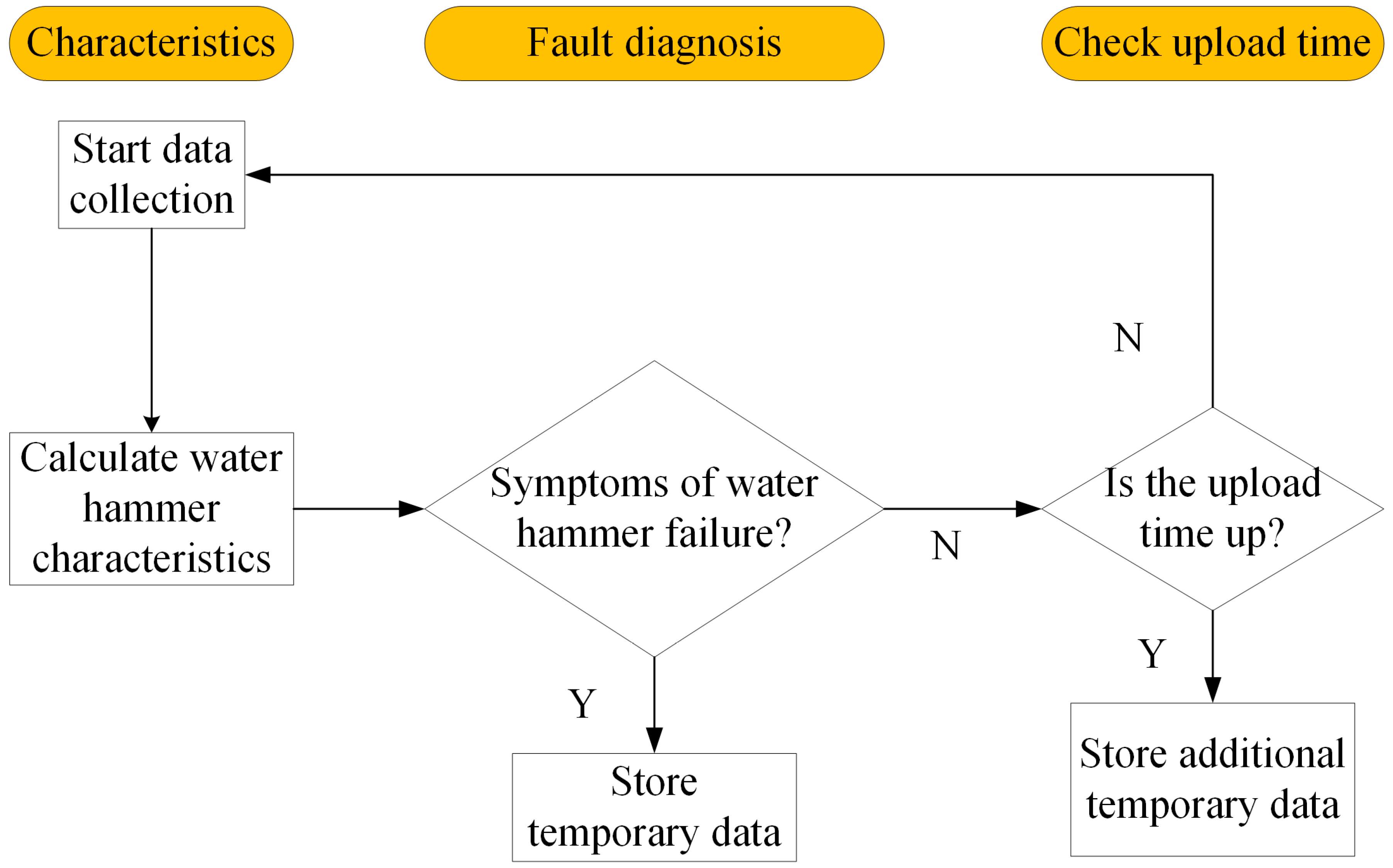
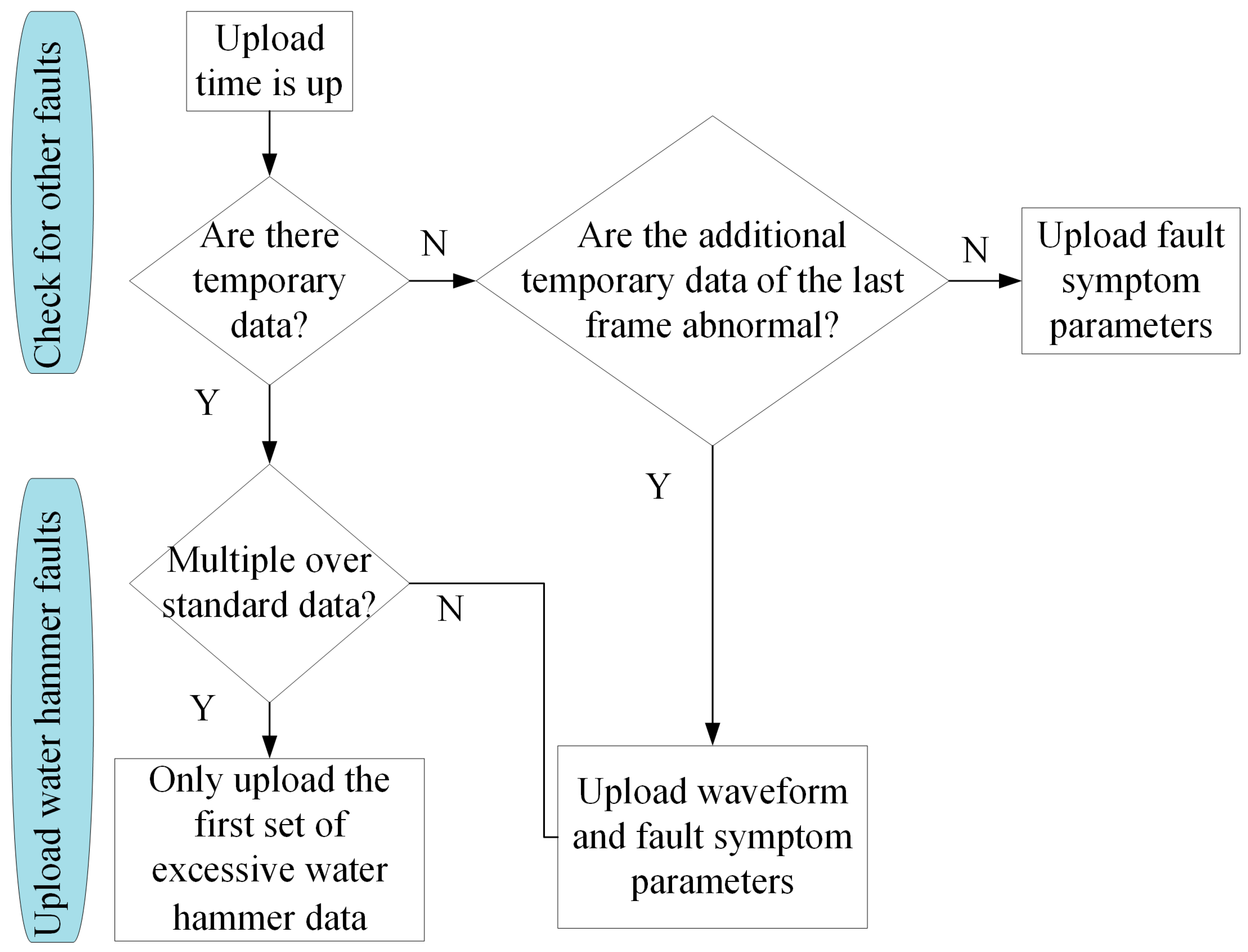
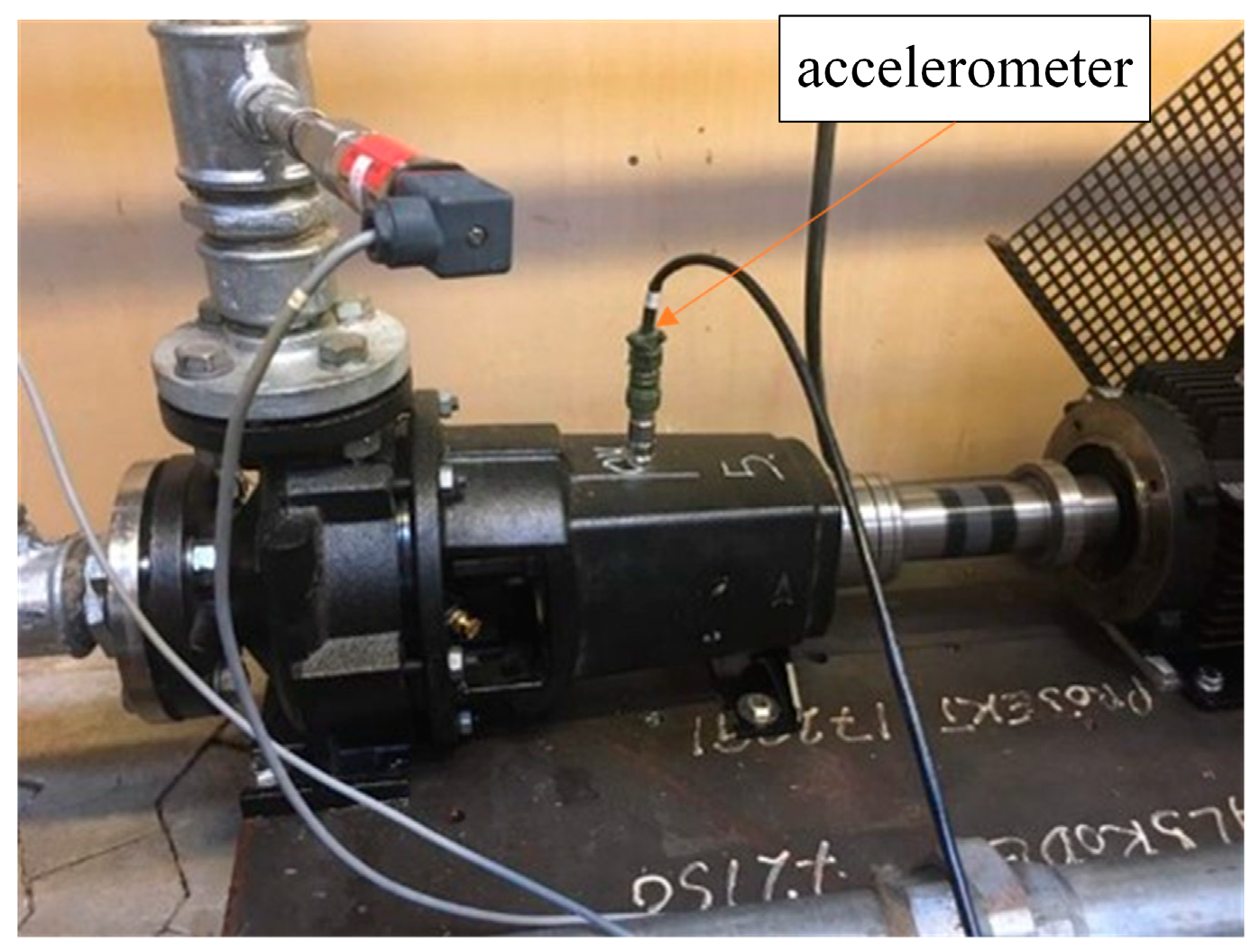
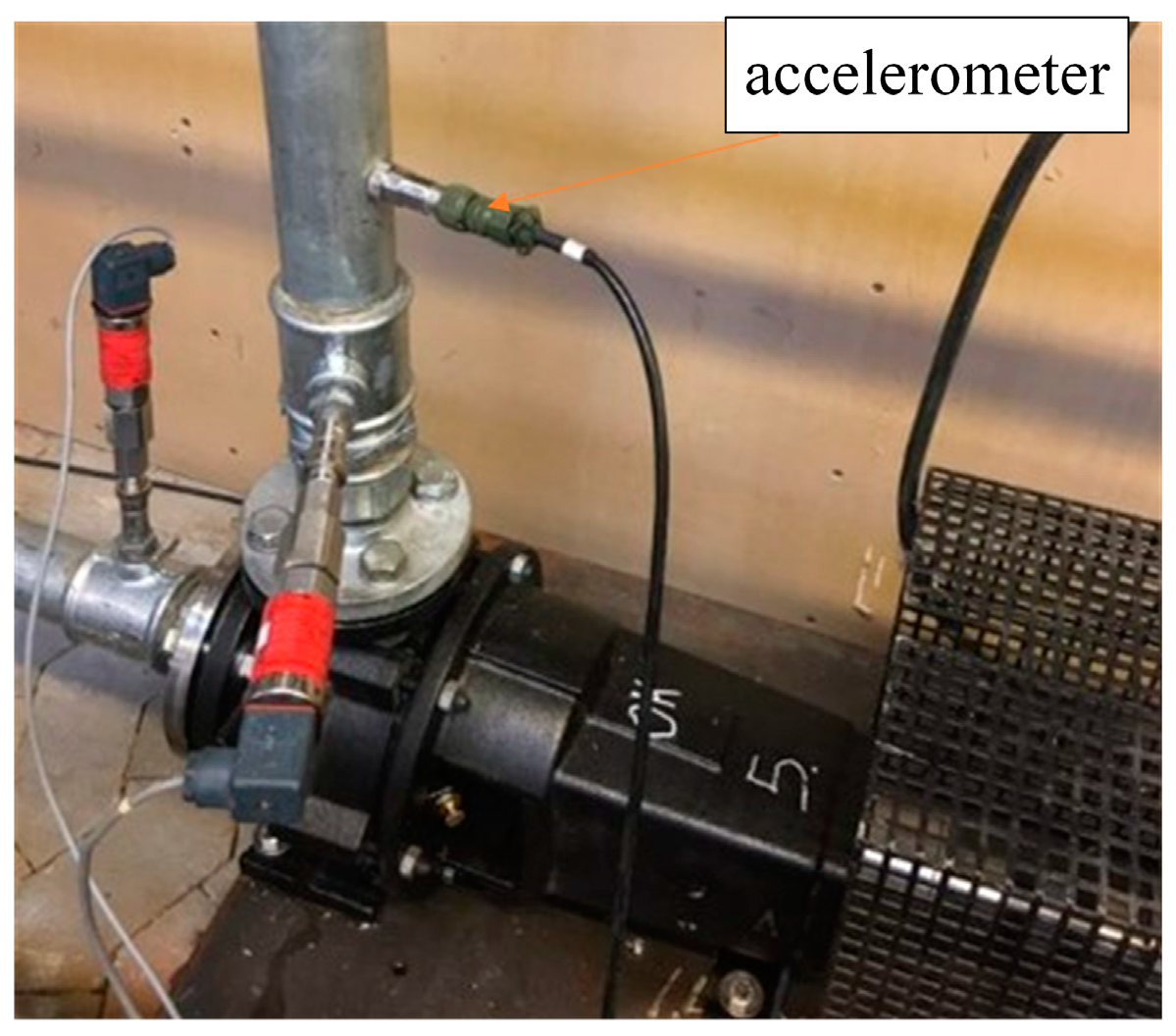
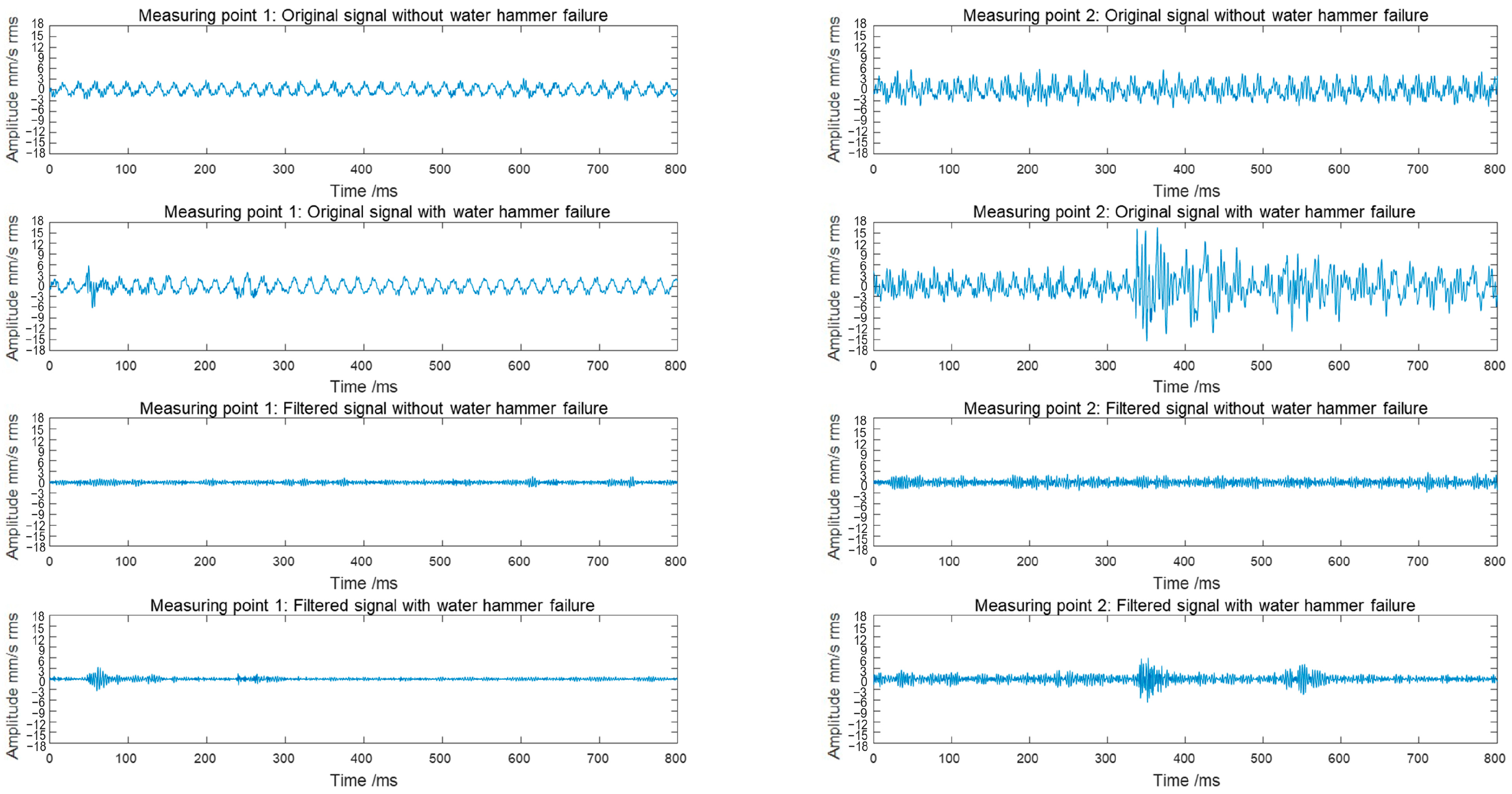
| Parameter | Measuring Point 1 | Measuring Point 2 | ||||
|---|---|---|---|---|---|---|
| Kurtosis Index | Pulse Index | Margin Index | Kurtosis Index | Pulse Index | Margin Index | |
| Original signal without water hammer failure | 2.10 | 3.18 | 3.58 | 2.57 | 3.72 | 4.34 |
| Original signal with water hammer failure | 2.49 | 4.91 | 5.52 | 4.86 | 6.25 | 7.66 |
| Multiple | 1.19 | 1.54 | 1.54 | 1.89 | 1.68 | 1.76 |
| Filtered signal without water hammer failure | 3.12 | 5.09 | 6.00 | 2.91 | 4.61 | 5.44 |
| Filtered signal with water hammer failure | 12.18 | 11.70 | 14.40 | 7.61 | 9.54 | 11.79 |
| Multiple | 3.90 | 2.30 | 2.40 | 2.64 | 2.07 | 2.18 |
Disclaimer/Publisher’s Note: The statements, opinions and data contained in all publications are solely those of the individual author(s) and contributor(s) and not of MDPI and/or the editor(s). MDPI and/or the editor(s) disclaim responsibility for any injury to people or property resulting from any ideas, methods, instructions or products referred to in the content. |
© 2024 by the authors. Licensee MDPI, Basel, Switzerland. This article is an open access article distributed under the terms and conditions of the Creative Commons Attribution (CC BY) license (https://creativecommons.org/licenses/by/4.0/).
Share and Cite
Chen, L.; Li, Z.; Shi, W.; Li, W. Research on Fault Detection and Automatic Diagnosis Technology of Water Hammer in Centrifugal Pump. Appl. Sci. 2024, 14, 5606. https://doi.org/10.3390/app14135606
Chen L, Li Z, Shi W, Li W. Research on Fault Detection and Automatic Diagnosis Technology of Water Hammer in Centrifugal Pump. Applied Sciences. 2024; 14(13):5606. https://doi.org/10.3390/app14135606
Chicago/Turabian StyleChen, Lei, Zhenao Li, Wenxuan Shi, and Wenlong Li. 2024. "Research on Fault Detection and Automatic Diagnosis Technology of Water Hammer in Centrifugal Pump" Applied Sciences 14, no. 13: 5606. https://doi.org/10.3390/app14135606





